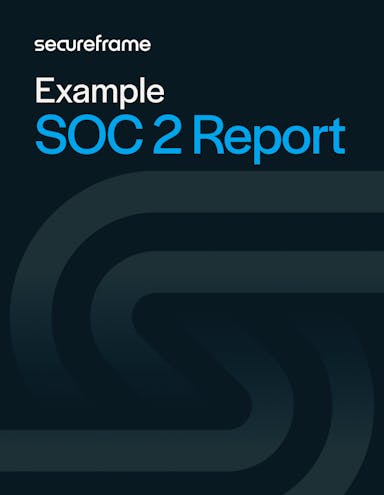
Compliance Report: What Are the Different Types and Examples + Why Get One?
Anna Fitzgerald
Senior Content Marketing Manager
Rob Gutierrez
Senior Cybersecurity and Compliance Manager, CISA, CCSK, CMMC RP
A new study found that consumers are willing to pay more for products from companies with strong and effective compliance programs.
This is merely one of the latest examples of how compliance is no longer a nice to have, but a requirement for winning revenue, maintaining customer trust, and meeting regulatory obligations.
One of the clearest ways to demonstrate your organization’s commitment to compliance? Having a compliance report in hand.
In this guide, we’ll explain what a compliance report is, why it matters, and share examples of reports your customers or other stakeholders may be asking for. Let’s get started.
What is a compliance report?
A compliance report is a document—usually generated by an independent auditor—that demonstrates how your organization meets specific laws, regulations, standards, or frameworks. It’s primarily used to provide assurance to regulators, auditors, customers, partners, and internal stakeholders that you meet security and privacy expectations.
This was the case for the global tokenization platform Basis Theory, who sought out a PCI compliance report to increase consumer confidence and attract top tier investors.
“Given we’re a young company, having our PCI certification shows our customers that we’re serious about keeping data secure.” —Matthew Trisoline, Senior Platform Engineer, Basis Theory
In addition to this external validation, a compliance report can be used to drive improvements internally by promoting accountability across the organization for upholding cybersecurity and data privacy standards, for example, or uncovering areas of improvement in policies, processes, or training.
For example, developer portal startup Roadie had essential security practices in place, but they needed to formalize these practices to achieve SOC 2 compliance. Having a SOC 2 Type II compliance report not only helped accelerate their sales cycle—it also deepened the engagement and ownership of the engineering team over their security practices.
“It brings compliance into the engineering mindset and into their hands. It makes it part of their work and something that they can be proud of and be involved in, which is something I've never seen before. In addition to time saved and being able to speed up the sales cycle, having that sense of ownership among the engineers is just incredible.” –Orla Tuite, Chief of Staff, Roadie
These two use cases are aligned with the two major categories of compliance reports:
- Internal compliance reports: These result from an internal audit and can be created by management and security leaders to monitor and report on compliance status and identify and proactively manage organizational risk.
- External compliance reports: These result from an external audit and, once issued by the auditor, can be shared with regulators, other auditors, customers, prospects, and partners, to prove adherence to requirements.
There are usually requirements around distribution of external compliance reports that the organization must follow. For example, most organizations share their SOC 2 reports only with customers and prospects that request it and agree to sign a non-disclosure agreement (NDA), but organizations can post their SOC 3 report on their website or otherwise distribute it freely.
Whether internal or external, a compliance report serves as a record of accountability, showing how your organization aligns with the requirements and rules that matter in your industry. Let’s dive deeper into the purpose of these reports.
Recommended reading

The Competitive Advantage of Compliance: 9 Reasons to Prioritize Data Security and Privacy
Why compliance reports matter
Compliance reports or certificates are more than paperwork. In fact, they are a crucial aspect of the sales process today. According to A-LIGN's research, 29% of organizations have lost a new business deal because they were missing a compliance certification and 72% have conducted an audit or assessment to help win new business.
Here are all the key ways that compliance reports can be used to benefit your business:
- Unblocking deals that would have been held up by security concerns or tedious questionnaires. For example, the startup Abmatic AI was able to get a SOC 2 compliance report in six business days and close deals with two major customers who had required this report before moving forward.
- Providing proof of successful audits and assessments like SOC 2, ISO 27001, HIPAA, PCI DSS, FedRAMP, and CMMC as well as your current compliance status. For example, having a HIPAA compliance report has helped the healthcare organization Bento get to the next growth phase and close deals quickly.
- Demonstrating accountability and transparency to customers, partners, regulators, boards, and other stakeholders. This was the case for software company Inflectra, whose team knew that obtaining a SOC 2 compliance report would help meet customer requirements while providing external validation of their strong focus on security.
- Tracking and reporting on compliance activities to identify any gaps, plan and track remediation efforts, and ensure continuous improvement over time. This can be particularly valuable during third-party investigations, like when the U.S. Department of Justice evaluates the effectiveness of a corporate compliance program when an organization is facing a criminal enforcement action. During such evaluations, the DOJ will look for proactive efforts, including whether the organization underwent internal and/or external audits and got compliance reports to test the effectiveness of its controls and overall compliance program over time.
- Gaining a competitive advantage over non-compliant competitors who can’t provide the same assurance to prospects that they’re meeting rigorous information security requirements. Achieving ISO 27001 certification gave Open Assessment Technologies an advantage over competitors who had not yet attained similar security credentials, for instance.
- Reducing reputational and regulatory risk by showing you’ve taken proactive steps to comply with laws and frameworks that apply to your industry, location, or data. This is one of the key reasons that Manufacturing Consulting Concepts completed a third-party assessment for NIST 800-171 and CMMC.

Without compliance reporting, organizations risk deals (especially with enterprise customers), fines, loss of customer trust, and even lawsuits, among other serious consequences.
Recommended reading

Non-Compliance Fines and Sanctions: Why It’s More Expensive Not to Comply with Regulations
Types of compliance reports
There are several types of compliance reports that regulators, customers, or other stakeholders may request for assurance that you’re adhering to regulatory requirements, industry standards, or internal policies—whether you’re a large enterprise or a small business.
We’ll provide a brief overview of the most common compliance report types below.
Cybersecurity compliance reports
This type of report helps provide assurance of the security and resilience of information systems and data. These often result from cybersecurity audits for commercial or voluntary cybersecurity frameworks, rather than regulatory frameworks (although they can). Two of the most common examples are SOC 2 reports and ISO 27001 certificates, which are considered leading standards for data security.
Regulatory compliance reports
This report type demonstrates compliance with government or industry regulations that are often legally or contractually mandated.
For example, a PCI DSS compliance report, such as the PCI Report on Compliance (RoC), is not legally mandated for companies handling cardholder data, but is mandated by payment card companies including Visa, Mastercard, American Express, and other major card brands.
Several federal frameworks require organizations to complete assessments that may result in audit reports or certificates of compliance, such as:
- CJIS audit reports for organizations working with criminal justice data.
- CMMC certificates for defense contractors handling federal contract information (FCI) and controlled unclassified information (CUI).
- FedRAMP authorization packages for cloud service providers pursuing federal authorization to operate (ATO).
Financial compliance reports
This report type ensures organizations are meeting accounting and financial reporting requirements. The most common example is SOX reports, which are mandated by the Sarbanes-Oxley Act to verify the accuracy and integrity of financial statements and internal controls.
Environmental compliance reports
This report type demonstrates an organization’s ESG compliance, or adherence to environmental, social, and governance guidelines created by governmental and regulatory bodies or internally by the organization itself.
For example, assurance reports are required under the EU’s Corporate Sustainability Reporting Directive (CSRD). Organizations must publish reports on environmental and social risks and the impact of their operations and have them reviewed by external auditors.
Health and Safety Compliance Reports
This report type often stems from voluntary or mandatory audits under workplace health and safety frameworks. For example, organizations that undergo voluntary safety and health audits under the Occupational Safety and Health Act (OSHA) can get a compliance report.
Similarly, healthcare organizations can undergo voluntary audits or use a compliance automation platform to get a HIPAA attestation report to share with prospects and other stakeholders (like Bento did).
Data privacy compliance reports
Data privacy regulations require organizations to demonstrate adherence to laws governing personal data. For example, certain organizations under India’s Digital Personal Data Protection Act (DPDPA) must undergo regular independent audits to verify compliance, and ensure audit reports are submitted to the Data Protection Board for oversight.
Similar to organizations that want to demonstrate HIPAA compliance, organizations in scope for the EU’s landmark data privacy law can undergo audits or use a compliance automation platform to get a GDPR attestation report to share with prospects and other stakeholders.
Recommended reading

Compliance Risk: How To Assess and Manage It in 2026 [+ Templates]
Compliance report examples
Below are specific examples of compliance reports that fall into the different categories above.
While they vary in content, technical detail, and structure, all these reports share the same goal: proving compliance in a way that’s measurable and auditable.
Find an overview of these compliance report types and examples in the table below, as well as more details in the section below.
| Report type | Report example | What it is | Who it’s applicable to |
|---|---|---|---|
| Cybersecurity | SOC 2 report | Independent CPA attestation verifying controls against SOC 2 Trust Services Criteria | Service organizations that need to provide customers and prospects with third-party assurance of data security |
| SOC 3 report | Public-facing summary of SOC 2 results without sensitive details | Service organizations that want to use a compliance report for marketing and trust-building with customers, partners, and the general public | |
| ISO 27001 certificate | Independent auditor’s validation of ISMS against ISO/IEC 27001 | Organizations that want to demonstrate their ISO 27001 compliance to global customers, regulators, and partners | |
| Regulatory | PCI Report on Compliance (RoC) | Annual QSA-issued report validating adherence to PCI DSS requirements | Merchants, service providers, and payment processors handling large amounts of cardholder data |
| HIPAA compliance report | Documentation of an organization’s adherence to HIPAA requirements | Healthcare organizations and their business associates that want to showcase their regulatory adherence and commitment to safeguarding PHI | |
| CMMC certificate | Certification proving compliance with CMMC level requirements | Defense contractors, subcontractors, and service providers in the DIB that want to maintain eligibility for contracts involving sensitive unclassified information | |
| FedRAMP Security Assessment Report (SAR) | Document prepared by 3PAO that details FedRAMP assessment findings | Cloud service providers pursuing federal contracts must have SAR as part of complete authorization package to get listed in FedRAMP Marketplace | |
| Financial | SOX report | Summary of audit findings on internal controls over financial reporting | Publicly traded companies, subsidiaries, accounting firms, and private companies preparing to go public may need to present SOX audit report to management, the board, and regulatory bodies |
| SOC 1 report | Summary of audit findings of service organization’s controls impacting customer financial reporting | Companies providing services that could affect clients’ financial statements or internal controls over financial reporting | |
| Environmental | CSRD assurance report | External auditor’s validation of ESG disclosures under the EU CSRD | EU companies and multinationals subject to sustainability reporting requirements |
| Health & Safety | OSHA audit report | Document of results from workplace safety inspections or voluntary audits | Employers that want to demonstrate strong commitment to OSHA compliance and safe workplace conditions |
| Data privacy | DPDPA audit report | Evidence of compliance with India’s Digital Personal Data Protection Act | Organizations processing large amounts or sensitive personal data of Indian residents |
SOC 2 report
A SOC 2 report is an attestation made by an independent CPA firm that verifies an organization meets one or more of five Trust Services Criteria (security, availability, processing integrity, confidentiality, privacy).
There are two types of SOC 2 reports:
- SOC 2 Type I reports evaluate a company’s controls at a single point in time. It answers the question: are the security controls designed properly?
- SOC 2 Type II reports assess how those controls function over a period of time, generally 3-12 months. It answers the question: do the security controls a company has in place function as intended?
Getting a SOC 2 report tells customers and prospects that you have the right safeguards in place to protect sensitive data.
Want to see what this report covers and how long and technically detailed it can be? Download our illustrative example of a SOC 2 Type 2 report.
SOC 3 report
Like a SOC 2 report, a SOC 3 report addresses controls relevant to the Trust Services Criteria. However, it is a more concise and high-level version of a SOC 2 report intended for general distribution to customers, partners, or the public.
Organizations often use SOC 3 reports as a marketing tool to build trust without exposing sensitive information about their system or controls.
ISO 27001 certificate
An ISO 27001 certificate is issued after an independent audit validates that an organization’s Information Security Management System (ISMS) meets the requirements of the ISO/IEC 27001 standard.
While it’s not mandatory to get certified, doing so provides stakeholders with third-party validation that the ISMS is well-designed, well-managed, and capable of protecting sensitive information.
PCI Report on Compliance (RoC)
A PCI Report on Compliance (RoC) is a compliance report required for organizations handling large volumes of payment card data. Conducted by a Qualified Security Assessor (QSA), a PCI DSS audit validates adherence to the 12 PCI DSS requirements. The RoC details whether the company meets all requirements and any deficiencies discovered during the audit.
This report is essential for Level 1 and some Level 2 merchants and service providers who must demonstrate secure handling of cardholder data. Organizations that fall into other levels will need to fill out a Self-Assessment Questionnaire (SAQ).
HIPAA compliance report
The Health Information Technology for Economic and Clinical Health Act of 2009 (HITECH) requires HHS to periodically audit covered entities and business associates for their compliance with HIPAA requirements.
To be prepared if you’re selected for one of these audits, you can create a HIPAA compliance report that documents how your organization secures protected health information (PHI). This report should cover all administrative, technical, and physical safeguards required by the HIPAA Security Rule.
While not always mandatory, these reports may be requested by regulators, business associates, or other stakeholders to verify compliance—especially since discoveries of HIPAA violations in internal audits or investigations of patient complaints and breaches can result in hefty fines.
CMMC certificate
A CMMC certificate demonstrates that a defense contractor or subcontractor has implemented the necessary controls and achieved the required SPRS score to pass a CMMC assessment at the level required in their contracts.
CMMC certification is required for organizations in the Defense Industrial Base (DIB) to handle sensitive unclassified information, including federal contract information (FCI) and controlled unclassified information (CUI). Those without a certificate risk losing their eligibility for existing and new contracts starting on November 10, 2025.
Note that organizations that undergo a C3PAO-led assessment for CMMC Level 2 compliance will get a summary report as well as a CMMC certificate.
FedRAMP Security Assessment Report (SAR)
A Security Assessment Report (SAR) is a document prepared by a Third-Party Assessment Organization (3PAO) that details the results of a FedRAMP assessment. It includes an evaluation of the effectiveness of the cloud service provider’s implemented security controls, any vulnerabilities or risks identified, and recommendations to remediate them.
This is one of many documents in a FedRAMP authorization package that must be submitted to the government to get listed in the Marketplace as FedRAMP Authorized. This provides federal agencies with assurance that a cloud service meets stringent cloud security requirements and can be a significant competitive advantage in the private sector as well.
SOX report
A SOX report summarizes the findings of an audit under one of the most significant financial regulations in US history. This report evaluates the effectiveness of internal controls over financial reporting and is presented to management, boards, and regulators.
As part of their financial reporting requirements, public companies must schedule annual audits so they have new SOX reports every year. These reports help ensure financial transparency and accountability in publicly traded companies.
SOC 1 report
A SOC 1 report details the audit findings of a service organization’s internal controls that are relevant to its customers’ financial reporting. It is particularly important for organizations that provide outsourced financial processing services, such as payroll processing or transaction handling, where customer financial statements may rely on the service organization's controls.
Like a SOC 2 report, there is a SOC 1 Type 1 and Type 2 report. While these reports aren’t mandatory, they are often requested by a service organization's clients and their auditors to validate the organization’s controls. This third-party assurance helps them feel more secure and comfortable about their financial statements and can often unblock deals.
CSRD assurance report
A CSRD assurance report is an external auditor’s validation of a company’s environmental and social reporting under the EU’s Corporate Sustainability Reporting Directive. This assurance report is made publicly available to provide assurance to regulators and other stakeholders that an organization’s ESG-related disclosures are credible. However, it’s important to note that this report does not validate the company’s performance as sustainable.
These requirements to report and obtain assurance over specified sustainability information are rolling out in waves, starting with Large Listed Entities in 2025.
OSHA audit report
An OSHA audit report documents the results of a workplace safety inspection or voluntary safety audit conducted under the Occupational Safety and Health Act. These reports can help organizations identify risks, maintain safe working environments, and demonstrate compliance with safety regulations.
Like HIPAA audits and attestation reports, OSHA audits and reports are not mandatory but may be requested by regulators or other stakeholders to verify compliance. Completing them proactively can reduce the risk of OSHA violations and citations as well as injuries, illnesses, and deaths in the workplace.
DPDPA audit report
A DPDPA audit report provides evidence of compliance with India’s Digital Personal Data Protection Act. While requirements for audits and the resulting findings are still being finalized, this report will likely detail the organization’s data protection mechanisms and compliance with the DPDPA, along with any corrective actions taken to align with the law.
Once the law is in effect, Significant Data Fiduciaries (SDFs)—organizations that process a large amount of personal data, process high-risk or sensitive data, or generate a significant amount of revenue from data processing activities—will be required to undergo regular independent audits to verify compliance and submit audit reports to the Data Protection Board for oversight.
Key elements of a compliance report
While every framework has its own audit and reporting requirements, most compliance reports include common components to answer the same two key questions:
- How was the audit conducted and what was tested?
- Are all framework requirements fully met?
Here is a high-level overview of the elements you can typically find in any compliance report:
- Executive summary of findings: Typically found at the beginning of a compliance report, an executive summary provides a high-level overview of the organization’s compliance status and report findings.
- Scope: Compliance reports must also define the scope of the audit, including which systems, processes, and controls were assessed, during what time period, and how. This is often a subsection within the executive summary.
- System description: Compliance reports include a description of the system being assessed, including details about its infrastructure and what controls have been put in place and why.
- Attestation of compliance: Most compliance reports will list out which requirements were met, not met, or not applicable. Testing results, policies, technical safeguards, audit logs, and other artifacts are attached or detailed to prove that the organization’s controls are designed and functioning effectively to meet the framework requirements (or not).
- Remediation or corrective actions: If any requirements were assessed as not met, then the report will include plans or recommendations for addressing gaps and nonconformities.
Recommended reading

Cybersecurity Remediation: A Guide to Protecting Your Business
Sample compliance report
To get a clearer sense of the content, format, and length of a compliance report, download the example below.

SOC 2 compliance report example
Download this illustrative example of a SOC 2 Type II Report for an in-depth look at what information this common compliance report might cover, how it’s organized, and how long it typically is.
Compliance report challenges and best practices
Having current compliance reports for all the laws, regulations, standards, policies, or frameworks that apply to your business, data, or customer expectations can be difficult—especially if you’re trying to manage your compliance program manually.
Common challenges include:
- Manual evidence collection across multiple tools and systems
- Keeping up with regulatory and framework changes that impact your compliance posture
- Inconsistent quality of reports across auditors (ie. different number of controls tested and different lengths)
- Managing audits for different frameworks and review cycles to keep reports current
- Spending hundreds of hours on compliance documentation
- Distributing reports to customers, prospects, and other stakeholders efficiently
Best practices to overcome these challenges include:
- Automating evidence collection wherever possible
- Using a compliance platform that is kept up-to-date with the latest regulations and frameworks
- Pick an audit firm with an experienced team and high-quality reports (technical details and comprehensiveness are key indicators of quality)
- Choose compliance management software that can drive your continuous compliance strategy and be a complete source of truth for all the tasks, evidence, controls, and requirements you need to manage across audits
- Use a trust center to showcase all compliance reports or certificates
Recommended reading

5 Hardest Things About Security Compliance and How Technology Can Help
How Secureframe can help you get the compliance reports you need—year after year
A compliance report is one of the most effective ways to demonstrate your organization’s commitment to security, privacy, and regulatory requirements—but managing multiple reports and keeping them current is challenging without the right tools and experts.
A compliance management system like Secureframe helps organizations streamline audit management and continuous compliance so they always have the visibility and validation they need to show their current compliance posture. Here’s how:
- Automatically collects evidence across 300+ integrations to speed up readiness
- Maps controls and tests to multiple frameworks to reduce duplicate work and streamline compliance before the first audit and every audit after
- Uses AI to simplify the process of remediating failing controls, completing risk and vendor assessments, creating and editing policies, and more to reduce time and effort of maintaining compliance
- Monitors controls and alerts you of any issues so you stay continuously compliant and audit-ready
- Offers real-time insights into your compliance status with a monitoring dashboard
- Compliance managers offer expert guidance and answer questions at every step of the process, including after you have your compliance report in hand
- Generates reports for clients or prospects across frameworks to demonstrate current compliance state with a gap assessment tool
- Proactively share your compliance reports and other security information in a customizable Trust Center
With automation and AI, we’ve shifted compliance from a burden into a competitive advantage for thousands of organizations. Request a demo to see how we can help you do the same.
Use trust to accelerate growth
FAQs
What is included in a compliance report?
A compliance report usually contains the following key components, although the content and format differs depending on the framework:
- Executive summary: High-level overview of compliance status and findings.
- Scope: Description of which systems, processes, and controls were assessed, when, and how.
- System description: Details about the infrastructure and controls in place.
- Attestation of compliance : Results showing which requirements were met, supported by evidence.
- Remediation plans: Recommendations or steps for addressing any gaps or nonconformities.
Is a PCI Report on Compliance different from other compliance reports?
Yes. A PCI RoC is a report that details the findings of an external audit performed by a Qualified Security Advisor (QSA) or Internal Security Assessor (ISA). This report shows whether an organization’s policies and procedures, configurations of networks and applications, and general security controls meet PCI DSS requirements.
It’s mandatory for Merchant Level 1 and Service Provider Level 1 organizations— meaning organizations that:
- Accept card payments in exchange for goods and services AND process over 6 million transactions per year; or
- Process cardholder data on behalf of another company AND process over 300 thousand transactions per year.
How often should compliance reports be updated?
The exact update cycle depends on the compliance framework. Most require organizations to complete an audit at least annually to have a current compliance report, but other frameworks extend that timeframe to triennially. For example, a SOC 2 report is typically only considered valid for 12 months, whereas an ISO 27001 certificate and CMMC Level 2 (C3PAO) certificate are valid for three years from the issue date (as long as ongoing monitoring and reporting requirements are met).

Anna Fitzgerald
Senior Content Marketing Manager
Anna Fitzgerald is a digital and product marketing professional with nearly a decade of experience delivering high-quality content across highly regulated and technical industries, including healthcare, web development, and cybersecurity compliance. At Secureframe, she specializes in translating complex regulatory frameworks—such as CMMC, FedRAMP, NIST, and SOC 2—into practical resources that help organizations of all sizes and maturity levels meet evolving compliance requirements and improve their overall risk management strategy.

Rob Gutierrez
Senior Cybersecurity and Compliance Manager, CISA, CCSK, CMMC RP
Rob Gutierrez is an information security leader with nearly a decade of experience in GRC, IT audit, cybersecurity, FedRAMP, cloud, and supply chain assessments. As a former auditor and security consultant, Rob performed and managed CMMC, FedRAMP, FISMA, and other security and regulatory audits. At Secureframe, he’s helped hundreds of customers achieve compliance with federal and commercial frameworks, including NIST 800-171, NIST 800-53, FedRAMP, CMMC, SOC 2, and ISO 27001.